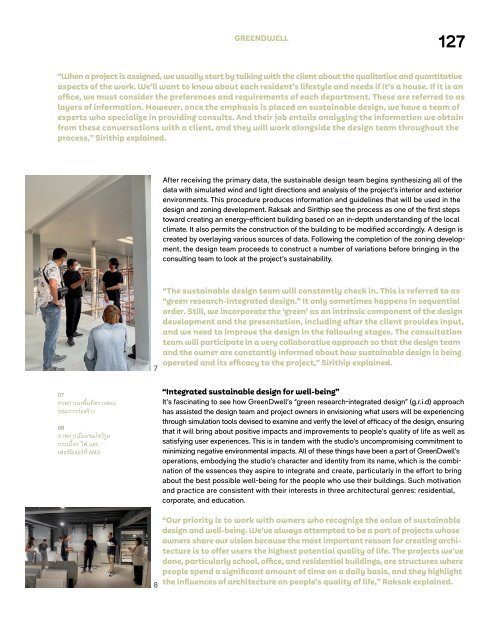ASA Journal 15/2023
You also want an ePaper? Increase the reach of your titles
YUMPU automatically turns print PDFs into web optimized ePapers that Google loves.
GREENDWELL<br />
127<br />
“When a project is assigned, we usually start by talking with the client about the qualitative and quantitative<br />
aspects of the work. We’ll want to know about each resident’s lifestyle and needs if it’s a house. If it is an<br />
office, we must consider the preferences and requirements of each department. These are referred to as<br />
layers of information. However, once the emphasis is placed on sustainable design, we have a team of<br />
experts who specialize in providing consults. And their job entails analyzing the information we obtain<br />
from these conversations with a client, and they will work alongside the design team throughout the<br />
process,” Sirithip explained.<br />
After receiving the primary data, the sustainable design team begins synthesizing all of the<br />
data with simulated wind and light directions and analysis of the project’s interior and exterior<br />
environments. This procedure produces information and guidelines that will be used in the<br />
design and zoning development. Raksak and Sirithip see the process as one of the first steps<br />
toward creating an energy-efficient building based on an in-depth understanding of the local<br />
climate. It also permits the construction of the building to be modified accordingly. A design is<br />
created by overlaying various sources of data. Following the completion of the zoning development,<br />
the design team proceeds to construct a number of variations before bringing in the<br />
consulting team to look at the project’s sustainability.<br />
7<br />
“The sustainable design team will constantly check in. This is referred to as<br />
“green research-integrated design.” It only sometimes happens in sequential<br />
order. Still, we incorporate the ‘green’ as an intrinsic component of the design<br />
development and the presentation, including after the client provides input,<br />
and we need to improve the design in the following stages. The consultation<br />
team will participate in a very collaborative approach so that the design team<br />
and the owner are constantly informed about how sustainable design is being<br />
operated and its efficacy to the project,” Sirithip explained.<br />
07<br />
ภาพการลงพื้นที่่ตรวจสอบ<br />
ขณะการก่อสร้าง<br />
08<br />
ภาพการเยี่ยมชมโชว์รูม<br />
กระเบื้อง ไฟ และ<br />
เฟอร์นิเจอร์ที่่ AMO<br />
“Integrated sustainable design for well-being”<br />
It’s fascinating to see how GreenDwell’s “green research-integrated design” (g.r.i.d) approach<br />
has assisted the design team and project owners in envisioning what users will be experiencing<br />
through simulation tools devised to examine and verify the level of efficacy of the design, ensuring<br />
that it will bring about positive impacts and improvements to people’s quality of life as well as<br />
satisfying user experiences. This is in tandem with the studio’s uncompromising commitment to<br />
minimizing negative environmental impacts. All of these things have been a part of GreenDwell’s<br />
operations, embodying the studio’s character and identity from its name, which is the combination<br />
of the essences they aspire to integrate and create, particularly in the effort to bring<br />
about the best possible well-being for the people who use their buildings. Such motivation<br />
and practice are consistent with their interests in three architectural genres: residential,<br />
corporate, and education.<br />
8<br />
“Our priority is to work with owners who recognize the value of sustainable<br />
design and well-being. We’ve always attempted to be a part of projects whose<br />
owners share our vision because the most important reason for creating architecture<br />
is to offer users the highest potential quality of life. The projects we’ve<br />
done, particularly school, office, and residential buildings, are structures where<br />
people spend a significant amount of time on a daily basis, and they highlight<br />
the influences of architecture on people’s quality of life,” Raksak explained.

















